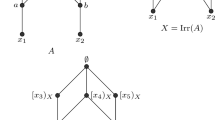Abstract
We establish a duality between the category of involutive bisemilattices and the category of semilattice inverse systems of Stone spaces, using Stone duality from one side and the representation of involutive bisemilattices as Płonka sum of Boolean algebras, from the other. Furthermore, we show that the dual space of an involutive bisemilattice can be viewed as a GR space with involution, a generalization of the spaces introduced by Gierz and Romanowska equipped with an involution as additional operation.
Similar content being viewed by others
References
Aqvist, L., Reflections on the logic of nonsense, Theoria 28(1):138–57, 1962.
Balbes, R., A representation theorem for distributive quasi-lattices, Fundamenta Mathematicae 68(2):207–214, 1970.
Bonzio, S., Dualities for Płonka sums, Logica Universalis, forthcoming. https://arxiv.org/abs/1804.02164.
Bonzio, S., J. Gil-Férez, F. Paoli, and L. Peruzzi, On paraconsistent weak Kleene logic: axiomatization and algebraic analysis, Studia Logica 105(2):253–297, 2017.
Bonzio, S., T. Moraschini, and M. Pra Baldi, Logics of left variable inclusion and Płonka sums of matrices. Submitted manuscript, 2018. https://arxiv.org/abs/1804.08897.
Bonzio, S., M. Pra Baldi, and D. Valota, Counting finite linearly ordered involutive bisemilattices. Submitted manuscript, 2018.
Brzozowski, J., De morgan bisemilattices, in 30th IEEE International Symposium on Multiple-Valued Logic, IEEE Press, 2000, pp. 23–25.
Ciuni, R., and M. Carrara, Characterizing logical consequence in paraconsistent weak Kleene, in L. Felline, A. Ledda, F. Paoli, and E. Rossanese, (eds.), New Developments in Logic and the Philosophy of Science, College, London, 2016.
Ciuni, R., T. Ferguson, and D. Szmuc, Logics based on linear orders of contaminating values. Submitted manuscript, 2017.
Clark, D., and B. Davey, Natural Dualities for the Working Algebraist. Cambridge Studies in Advanced Mathematics, Cambridge University Press, Cambridge, 1998.
Davey, B.A., Duality Theory on Ten Dollars a Day, Springer, Dordrecht, 1993, pp. 71–111.
Ferguson, T., A computational interpretation of conceptivism, Journal of Applied Non-Classical Logics 24(4):333–367, 2014.
Finn, V.K., and R. Grigolia, Nonsense logics and their algebraic properties, Theoria 59(1–3):207–273, 1993.
Gierz, G., and A. Romanowska, Duality for distributive bisemilattices, Journal of the Australian Mathematical Society, A 51:247–275, 1991.
Haimo, F., Some limits of Boolean algebras, Proceedings of the American Mathematical Society 2(4):566–576, 1951.
Halldén, S., The Logic of Nonsense, Lundequista Bokhandeln, Uppsala, 1949.
Harding, J., and A.B. Romanowska, Varieties of birkhoff systems part I, Order 34(1):45–68, 2017.
Harding, J., and A.B. Romanowska, Varieties of birkhoff systems part II, Order 34(1):69–89, 2017.
Hofmann, K., M. Mislove, and A. Stralka, The Pontryagin Duality of Compact O-Dimensional Semilattices and its Applications. Lecture Notes in Mathematics. Springer, 1974.
Kalman, J., Subdirect decomposition of distributive quasilattices, Fundamenta Mathematicae 2(71):161–163, 1971.
Kleene, S., Introduction to Metamathematics, North Holland, Amsterdam, 1952.
Lakser, H., R. Padmanabhan, and C.R. Platt, Subdirect decomposition of Płonka sums, Duke Mathematical Journal 39:485–488, 1972.
Ledda, A., Stone-type representations and dualities for varieties of bisemilattices, Studia Logica 106(2):417–448, 2018.
Mardešić, S., and J. Segal, Shape Theory: The Inverse System Approach. North-Holland Mathematical Library, North-Holland, 1982.
McKenzie, R., and A. Romanowska, Varieties of distributive bisemilattices, Contributions to General Algebra 1:213–218, 1979.
Mobasher, B., D. Pigozzi, and G. Slutzki, Multi-valued logic programming semantics an algebraic approach, Theoretical Computer Science 171(1):77–109, 1997.
Omori, H., Halldén’s logic of nonsense and its expansions in view of logics of formal inconsistency, in 27th International Workshop on Database and Expert Systems Applications, 2016, pp. 129–133.
Płonka, J., On a method of construction of abstract algebras, Fundamenta Mathematicae 61(2):183–189, 1967.
Płonka, J., On distributive quasilattices, Fundamenta Mathematicae 60:191–200, 1967.
Płonka, J., Some remarks on direct systems of algebras, Fundamenta Mathematicae 62(3):301–308, 1968.
Płonka, J., On sums of direct systems of Boolean algebras, Colloquium Mathematicae 21:209–214, 1969.
Płonka, J., On the sum of a direct system of universal algebras with nullary polynomials, Algebra Universalis 19(2):197–207, 1984.
Płonka, J., and A. Romanowska, Semilattice sums. Universal Algebra and Quasigroup Theory, 1992, pp. 123–158.
Priestley, H., Ordered topological spaces and the representation of distributive lattices, Proceedings of the London Mathematical Society 24:507–530, 1972.
Priestley, H., Ordered sets and duality for distributive lattices, in M. Pouzet and D. Richard, (eds.), Orders: Description and Roles, vol. 99 of North-Holland Mathematics Studies, North-Holland, 1984, pp. 39–60.
Prior, A., Time and Modality, Oxford University Press, Oxford, 1957.
Romanowska, A., and J. Smith, Semilattice-based dualities, Studia Logica 56(1/2):225–261, 1996.
Romanowska, A., and J. Smith, Duality for semilattice representations, Journal of Pure and Applied Algebra 115(3):289–308, 1997.
Segerberg, K., A contribution to nonsense-logics, Theoria 31:199–217, 1964.
Singer, I., and J. Thorpe, Lecture Notes on Elementary Topology and Geometry. Undergraduate Texts in Mathematics, Springer, New York, 1976.
Stone, M., Applications of the theory of Boolean rings to general topology, Transactions of the American Mathematical Society 41:375–481, 1937.
Szmuc, D., Defining LFIs and LFUs in extensions of infectious logics, Journal of Applied non Classical Logics 26(4):286–314, 2016.
Szmuc, D., B.D. Re, and F. Pailos, Theories of truth based on four-valued infectious logics, Logic Journal of the IGPL, forthcoming.
Williamson, T., Vagueness, Routledge, London, 1994.
Author information
Authors and Affiliations
Corresponding author
Additional information
Presented by Constantine Tsinakis
Rights and permissions
About this article
Cite this article
Bonzio, S., Loi, A. & Peruzzi, L. A Duality for Involutive Bisemilattices. Stud Logica 107, 423–444 (2019). https://doi.org/10.1007/s11225-018-9801-0
Received:
Published:
Issue Date:
DOI: https://doi.org/10.1007/s11225-018-9801-0




